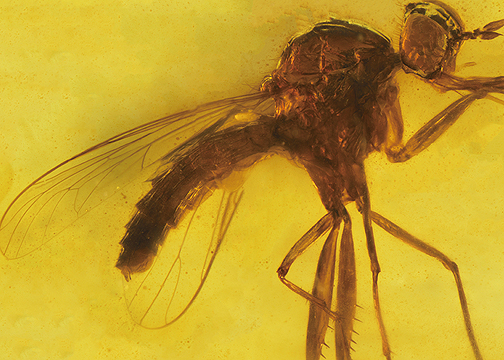Abstract
A new genus and species, Creapsilocephala nagatomii gen. et sp. nov. assigned to the enigmatic family Apsilocephalidae, was described from Mid-Cretaceous Burmese amber. The details of mouthpart structures in the new species are well preserved, revealing the non-piercing mouthparts that comprise an elongated labrum and tube-like hypopharynx, a pair of slender pointed laciniae, one-segmented palp, and prolonged labium. According to the analysis of mouthpart features, the food tube of the new species is constituted by the labrum and hypopharynx, which supports a nectar-feeding habit. This new finding enriches the species diversity of Cretaceous Apsilocephalidae and enhances the knowledge of the early biological features in this family.
References
- Cui, Y.Y., Bardin, J., Wipfler, B., Demers-Potvin, A., Bai, M., Tong, Y.J., Chen, G.N., Chen, H.R., Zhao, Z.Y., Ren, D. & Béthoux, O. (2024) A winged relative of ice‐crawlers in amber bridges the cryptic extant Xenonomia and a rich fossil record. Insect Science. https://doi.org/10.1111/1744-7917.13338
- Cumming, J.M. & Wood, D.M. (2017) Adult morphology and terminology. In: Kirk-Spriggs, A.H. & Sinclair, B.J. (Eds), Manual of Afrotropical Diptera. Volume 1. Introductory chapters and keys to Diptera families. Suricata 4, South African National Biodiversity Institute, Pretoria, pp. 89–133.
- Gaimari, S.D. & Mostovski, M. B. (2000) Burmapsilocephala cockerelli, a new genus and species of Asiloidea (Diptera) from Burmese amber. Bulletin of the Natural History Museum (Geology), 56, 43–46.
- Greenwalt, D.E., Amorim, D.S., Hauser, M., Kerr, P.H., Fitzgerald, S.J., Winterton, S.L., Cumming, J.M., Evenhuis, N.L. & Sinclair, B.J. (2022) Diptera of the Middle Eocene Kishenehn Formation II. Palaeontologia Electronica, 25, 1–52. https://doi.org/10.26879/1215
- Grimaldi, D.A. (2016) Diverse Orthorrhaphan flies (Insecta: Diptera: Brachycera) in amber from the Cretaceous of Myanmar: Brachycera in Cretaceous amber, Part VII. Bulletin of the American Museum of Natural History, 408, 1–131. https://doi.org/10.1206/0003-0090-408.1.1
- Grimaldi, D.A., Arillo, A., Cumming, J.M. & Hauser, M. (2011) Brachyceran Diptera (Insecta) in Cretaceous ambers, part IV, significant new orthorrhaphous taxa. ZooKeys, 148, 293–332. https://doi.org/10.3897/zookeys.148.1809
- Hauser, M. & Irwin, M.E. (2005) Fossil Therevidae (Insecta: Diptera) from Florissant, Colorado (Upper Eocene). Journal of Systematic Palaeontology, 3, 393–401. https://doi.org/10.1017/S1477201905001690
- Hauser, M. (2007) Baltic amber Therevidae and Apsilocephalidae (Diptera). Studia Dipterologica, 14, 37–59.
- Hennig, W. (1967) Therevidae aus dem baltischen Bernstein mit einigen Bemerkungen über Asilidae und Bombyliidae (Diptera, Brachycera). Stuttgarter Beiträge zur Naturkunde, 176, 1–14.
- Kröber, O. (1914) Beiträge zur Kenntnis der Thereviden und Omphal-iden. Jahrbuch der Hamburger Wissenschaftlichen Anstalt, 31, 29–74.
- Liu, Z.J., Huang, D.Y., Cai, C.Y. & Wang, X. (2018) The core eudicot boom registered in Myanmar amber. Scientific Reports, 8, 16765. https://doi.org/10.1038/s41598-018-35100-4
- Nagatomi, A., Saigusa, T., Nagatomi, H. & Lyneborg, L. (1991) Apsilocephalidae, a new family of the orthorrhaphous Brachycera (Insecta, Diptera). Zoological Science, 8, 579–591.
- Peñalver, E., Arillo, A., Peréz-de la Fuente, R., Riccio, M.L., Delclòs, X., Barrón, E. & Grimaldi, D.A. (2015) Long-proboscid flies as pollinators of Cretaceous gymnosperms. Current Biology, 25, 1917–1923. https://doi.org/10.1016/j.cub.2015.05.062
- Poinar, G.O., Jr. & Chambers, K.L. (2017) Tropidogyne pentaptera sp. nov., a new mid-Cretaceous fossil angiosperm flower in Burmese amber. Palaeodiversity, 10, 135–140. https://doi.org/10.18476/pale.v10.a10
- Poinar, G.O., Jr. & Vega, F.E. (2021) A new genus of Apsilocephalidae (Diptera) in mid-Cretaceous Burmese amber. Biosis: Biological Systems, 2, 183–190. https://doi.org/10.37819/biosis.002.01.0091
- Shi, C., Wang, S., Cai, H.H., Zhang, H.R., Long, X.X., Tihelka, E., Song, W.C., Feng, Q., Jiang, R.X., Cai, C.Y., Lombard, N., Li, X., Yuan, J., Zhu, J.P., Yang, H.Y., Liu, X.F., Xiang, Q.P., Zhao, Z.T., Long, C.L., Schneider, H., Zhang, X.C., Peng, H., Li, D.Z., Fan, Y., Engel, M.S., Wang, Y.D. & Spicer. R.A. (2022) Fire-prone Rhamnaceae with South African affinities in Cretaceous Myanmar amber. Nature Plants, 8, 125–135. https://doi.org/10.1038/s41477-021-01091-w
- Shi, G.H., Grimaldi, D.A., Harlow, G.E., Wang, J., Wang, J., Yang, M.C., Lei, W.Y., Li, Q.L. & Li, X.H. (2012) Age constraint on Burmese amber based on U-Pb dating of zircons. Cretaceous Research, 37, 155‒163. https://doi.org/10.1016/j.cretres.2012.03.014
- Solórzano-Kraemer, M.M. & Cumming, J.M. (2019) New genera of brachyceran flies (Diptera: Xylomyidae and Apsilocephalidae) from mid-Cretaceous Hukawng Valley Burmese amber. Palaeoentomology, 2 (3), 251–261. https://doi.org/10.11646/palaeoentomology.2.3.10
- Wang, J.J., Zhang, W.T., Engel, M.S., Sheng, X.Y., Shih, C. & Ren, D. (2022) Early evolution of wing scales prior to the rise of moths and butterflies. Current Biology, 32, 3808–3814. https://doi.org/10.1016/j.cub.2022.06.086
- White, A. (1914) Families Leptidae, Stratiomyidae, Nemestrinidae and Cyrtidae. In: The Diptera-Brachycera of Tasmania. Part I. Papers & Proceedings of the Royal Society of Tasmania, pp. 35–74. https://doi.org/10.5962/bhl.part.19950
- Winterton, S.L. & Irwin, M.E. (2008) Kaurimyia gen. nov.: discovery of Apsilocephalidae (Diptera: Therevoid clade) in New Zealand. Zootaxa, 1779, 38–44. https://doi.org/10.11646/zootaxa.1779.1.3
- Winterton, S.L. & Gaimari, S.D. (2017) Scenopinidae. In: Kirk-Spriggs, A.H. & Sinclair, B.J. (Eds), Manual of Afrotropical Diptera. Volume 2. Nematocerous Diptera and lower Brachycera. Suricata 5, South African National Biodiversity Institute, Pretoria, pp. 1209–1219.
- Yeates, D.K., Irwin M.E. & Wiegmann, B.M. (2003) Ocoidae, a new family of asiloid flies (Diptera: Brachycera: Asiloidea), based on Ocoa chilensis gen. and sp. n. from Chile, South America. Systematic Entomology, 28, 417–431. https://doi.org/10.1046/j.1365-3113.2003.00224.x
- Ye, X.N., Yang, G., Shih, C., Ren, D. & Wang, Y.J. (2019) New bee flies from the mid-Cretaceous Myanmar amber (Brachycera: Asiloidea: Bombyliidae). Cretaceous Research, 100, 5–13. https://doi.org/10.1016/j.cretres.2019.03.026
- Zhang, H.Q., Shih, C., Ren, D. & Wang, Y.J. (2020) New Alavesia species from mid-Cretaceous Burmese amber highlight genitalic structural homology (Diptera: Empidoidea: Atelestidae). Cretaceous Research, 116, 104573. https://doi.org/10.1016/j.cretres.2020.104573
- Zhang, Q.Q., Li, X.K., Xu, B.Q., Zhu, Y.M., Lu, R.Q., Wang, B. & Yeates, D.K. (2018) Two new genera of Apsilocephalidae from mid-Cretaceous Burmese amber. Cretaceous Research, 84, 525–532. https://doi.org/10.1016/j.cretres.2017.11.026
- Zhang, Y.J., Rasnitsyn, A.P., Zhang, W.W., Song, F., Shih, C., Ren, D., Wang, Y.J., Li, H. & Gao, T.P. (2024) Stem chewing lice on Cretaceous feathers preserved in amber. Current Biology, 36, 916–922. https://doi.org/10.1016/j.cub.2024.01.027


